Grid Interconnection Modeling of Inverter Based Resources (IBR) Plant for Transient Analysis
Abstract
1. Introduction
2. Inverter-Based Resources Plant Grid Interconnection and Control
2.1. IBR Plant
2.2. Control of an IBR Plant
3. Approximate EMT Circuit Models of IBR Plant Connected to the Grid
- The collector system impedance is neglected and all IBRs in the IBR plant have the same filter parameter.
- All IBRs in the IBR plant have the same output terminal voltage.
- All IBRs in the IBR plant have different output terminal voltages.
- The collector system impedance is considered, and all IBRs in the IBR plant have distinct filter characteristics.
- Each IBR in the IBR plant is coupled to the POM in parallel through different collector impedances; therefore, they output different terminal voltage.
- Each IBR in the IBR plant is connected in a series and parallel combination to the POM through a collector system (depicted in Figure 1b), and they output different terminal voltage.
3.1. A Grid-Connected IBR Plant Including IBRs, IBR Filters, Collector Impedances, and Grid Impedance
3.2. Case 2: IBRs with Identical Filter Parameters but Different Terminal Voltages
3.3. Case 3: IBRs with Different Filter Parameters and Different Terminal Voltages—Each IBR Is Coupled in Parallel to the POM through a Different Collector Impedance
- (1)
- An average IBR represents an IBR plant consist of n IBRs, which outputs the average terminal voltage of all IBRs in the IBR plant as follows:
- (2)
- The filter characteristics of the average IBR are given by averaging the values of filter parameters of all the IBRs in the IBR plant as follows:
- (3)
- The collector system parameters( and ) of the average IBR are given by averaging the collector system parameters ( and ) connecting all the IBRs to the POM as follows
3.4. Case 4: IBRs with Different Filter Parameters and Different Terminal Voltages—Each IBR Is Coupled in a Combination of Series and Parallel to the POM through a Collector System (As Depicted in Figure 1b)
- (1)
- An average IBR represents all IBRs in an IBR plant. The average IBR outputs the average terminal voltages of all IBRs in the IBR plant as shown in (27).
- (2)
- The filter characteristics of the average IBR are given by averaging the values of filter parameters of all the IBRs in the IBR plant as shown in (28).
- (3)
- Similar to Figure 1b, assume an IBR plant has K parallel feeders, and each parallel feeder has Nk number of series paths. Equation (30a) provides the approximate and aggregated average impedance of collector system of each feeder. Therefore, the overall collector system (with K parallel feeders) parameters of an IBR plant are obtained from Equation (30b).where, Rki and Lki denote the resistance and inductance of the ith series path within the kth parallel feeder, and Rk_avg and Lk_avg stand for the approximate and aggregated average resistance and inductance of the kth parallel feeder.
- (4)
- By replacing the parameters developed in (27), (28), and (30) into Figure 7b, the equivalent and approximate EMT circuit model is obtained.
4. EMT Simulation Model of IBR Plant Grid Interconnection
4.1. Approximated EMT Model of Case 1
4.2. Approximated EMT Model of Case 2
4.3. Approximated EMT Model of Case 3
4.4. Approximated EMT Model of Case 4
4.5. Detailed IBR Plant Model in a Recursive Way
5. Approximated IBR Plant Grid Interconnection Model Simulation and Its Validation with Detailed Recursive Model
5.1. Approximated IBR Plant Model Evaluation of Case 1
5.2. Approximated IBR Plant Model Evaluation of Case 2
5.3. Approximated IBR Plant Model Evaluation of Case 3
5.4. Approximated IBR Plant Model Evaluation of Case 4
5.5. Performance Evaluation of the Approximate IBR Plant Model during Abnormal Operation Conditions
6. Conclusions
Author Contributions
Funding
Data Availability Statement
Acknowledgments
Conflicts of Interest
Nomenclature
| BPS | Bulk Power System |
| DER | Distributed Energy Resource |
| DG | Distributed Generation |
| EMT | Electromagnetic Transient |
| GCI | Grid Connected Inverter |
| IBR | Inverter Based Resources |
| MCC | Modular Multilevel Converter |
| MV | Medium Voltage |
| PCC | Point of Common Coupling |
| POI | Point of Interconnection |
| POM | Point of Measurement |
| PV | Photovoltaic |
| RES | Renewable Energy Source |
| SPP | Solar Power Plant |
| THD | Total Harmonic Distortion |
| WT | Wind Turbine |
| WPP | Wind Power Plant |
References
- Lu, B.; Li, S.; Gao, Y.; Das, H.S. P-Q Capability Analysis of Inverter Based Resources with Typical Grid Connected Filters. In Proceedings of the 2020 IEEE Power & Energy Society General Meeting (PESGM), Montreal, QC, Canada, 2–6 August 2020; pp. 1–6. [Google Scholar] [CrossRef]
- IEEE 2800-2022; IEEE Standard for Interconnection and Interoperability of Inverter-Based Resources (IBRs) Interconnecting with Associated Transmission Electric Power Systems. IEEE: Manhattan, NY, USA, 22 April 2022.
- Xie, X.; Zhang, X.; Liu, H.; Liu, H.; Li, Y.; Zhang, C. Characteristic Analysis of Subsynchronous Resonance in Practical Wind Farms Connected to Series-Compensated Transmissions. IEEE Trans. Energy Convers. 2017, 32, 1117–1126. [Google Scholar] [CrossRef]
- Luhtala, R.; Messo, T.; Roinila, T.; Alenius, H.; De Jong, E.; Burstein, A.; Fabian, A. Identification of Three-Phase Grid Impedance in the Presence of Parallel Converters. Energies 2019, 12, 2674. [Google Scholar] [CrossRef]
- Gul, M.U.; Ahmed, A.; Warraich, A. A practical method for equivalencing of a large wind farm with multiple turbine representation. In Proceedings of the 2018 IEEE 7th International Conference on Power and Energy (PECon), Kuala Lumpur, Malaysia, 3–4 December 2018; pp. 156–161. [Google Scholar] [CrossRef]
- Kim, D.-E.; El-Sharkawi, M.A. Dynamic Equivalent Model of Wind Power Plant Using Parameter Identification. IEEE Trans. Energy Convers. 2015, 31, 37–45. [Google Scholar] [CrossRef]
- Kim, D.-E.; El-Sharkawi, M.A. Dynamic Equivalent Model of Wind Power Plant Using an Aggregation Technique. IEEE Trans. Energy Convers. 2015, 30, 1639–1649. [Google Scholar] [CrossRef]
- Muljadi, E.; Pasupulati, S.; Ellis, A.; Kosterov, D. Method of equivalencing for a large wind power plant with multiple turbine representation. In Proceedings of the 2008 IEEE Power and Energy Society General Meeting—Conversion and Delivery of Electrical Energy in the 21st Century, Pittsburgh, PA, USA, 20–24 July 2008. [Google Scholar]
- Elizondo, M.A.; Lu, S.; Zhou, N.; Samaan, N. Model reduction, validation, and calibration of wind power plants for dynamic studies. In Proceedings of the 2011 IEEE Power and Energy Society General Meeting, Detroit, MI, USA, 24–28 July 2011; pp. 1–8. [Google Scholar] [CrossRef]
- Yan, L.; Yongning, C.; Haiyan, T.; Xinshou, T.; Yuanzhu, C. Wind Farm Equivalent Model Based on Power Output Sensitivity of Wind Turbines. In Proceedings of the 2019 IEEE Sustainable Power and Energy Conference (iSPEC), Beijing, China, 21–23 November 2019; pp. 76–80. [Google Scholar] [CrossRef]
- Dozein, M.G.; Chaspierre, G.; Mancarella, P.; Panciatici, P.; Van Cutsem, T. Frequency Response from Solar PV: A Dynamic Equivalence Closed-Loop System Identification Approach. IEEE Syst. J. 2021, 16, 713–722. [Google Scholar] [CrossRef]
- Remon, D.; Cantarellas, A.M.; Rodriguez, P. Equivalent Model of Large-Scale Synchronous Photovoltaic Power Plants. IEEE Trans. Ind. Appl. 2016, 52, 5029–5040. [Google Scholar] [CrossRef]
- Hart, P.J.; Lasseter, R.H.; Jahns, T. Reduced-order harmonic modeling and analysis of droop-controlled distributed generation networks. In Proceedings of the 2016 IEEE 7th International Symposium on Power Electronics for Distributed Generation Systems (PEDG), Vancouver, BC, Canada, 27–30 June 2016. [Google Scholar]
- Hart, P.J.; Lasseter, R.H.; Jahns, T.M. Enforcing coherency in droop-controlled inverter networks through use of advanced voltage regulation and virtual impedance. In Proceedings of the 2017 IEEE Energy Conversion Congress and Exposition (ECCE), Cincinnati, OH, USA, 1–5 October 2017. [Google Scholar]
- Li, C.; Xu, J.; Zhao, C. A Coherency-Based Equivalence Method for MMC Inverters Using Virtual Synchronous Generator Control. IEEE Trans. Power Deliv. 2016, 31, 1369–1378. [Google Scholar] [CrossRef]
- Purba, V.; Dhople, S.V.; Jafarpour, S.; Bullo, F.; Johnson, B.B. Reduced-order structure-preserving model for parallel-connected three-phase grid-tied inverters. In Proceedings of the 2017 IEEE 18th Workshop on Control and Modeling for Power Electronics (COMPEL), Stanford, CA, USA, 9–12 July 2017; pp. 1–7. [Google Scholar] [CrossRef]
- Purba, V.; Johnson, B.B.; Rodriguez, M.; Jafarpour, S.; Bullo, F.; Dhople, S.V. Reduced-order Aggregate Model for Parallel-connected Single-phase Inverters. IEEE Trans. Energy Convers. 2018, 34, 824–837. [Google Scholar] [CrossRef]
- Gupta, A.P.; Mitra, A.; Mohapatra, A.; Singh, S.N. A Multi-Machine Equivalent Model of a Wind Farm Considering LVRT Characteristic and Wake Effect. IEEE Trans. Sustain. Energy 2022, 13, 1396–1407. [Google Scholar] [CrossRef]
- Liu, B.; Li, Z.; Wang, H.; Dong, X.; Su, W.; Li, G.; Chen, X.; Fernando, T.; Iu, H.H.C.; Lian, X.; et al. Impedance Modeling of DFIG Wind Farms with Various Rotor Speeds and Frequency Coupling. IEEE Trans. Circuits Syst. II Express Briefs 2020, 68, 406–410. [Google Scholar] [CrossRef]
- Wang, X.; Yu, H.; Lin, Y.; Zhang, Z.; Gong, X. Dynamic Equivalent Modeling for Wind Farms with DFIGs Using the Artificial Bee Colony With K-Means Algorithm. IEEE Access 2020, 8, 173723–173731. [Google Scholar] [CrossRef]
- Zhu, L.; Zhang, J.; Zhong, D.; Wang, B.; Wu, Z.; Xu, M.; Li, Q. A Study of Dynamic Equivalence Using the Similarity Degree of the Equivalent Power Angle in Doubly Fed Induction Generator Wind Farms. IEEE Access 2020, 8, 88584–88593. [Google Scholar] [CrossRef]
- Chao, P.; Li, W.; Liang, X.; Xu, S.; Shuai, Y. An Analytical Two-Machine Equivalent Method of DFIG-Based Wind Power Plants Considering Complete FRT Processes. IEEE Trans. Power Syst. 2021, 36, 3657–3667. [Google Scholar] [CrossRef]
- Liu, M.; Pan, W.; Zhang, Y.; Zhao, K.; Zhang, S.; Liu, T. A Dynamic Equivalent Model for DFIG-Based Wind Farms. IEEE Access 2019, 7, 74931–74940. [Google Scholar] [CrossRef]
- Wang, P.; Zhang, Z.; Huang, Q.; Wang, N.; Zhang, X.; Lee, W.-J. Improved Wind Farm Aggregated Modeling Method for Large-Scale Power System Stability Studies. IEEE Trans. Power Syst. 2018, 33, 6332–6342. [Google Scholar] [CrossRef]
- Jinxin, O.; Yanbo, D.; Di, Z.; Rui, Y.; Xi, Z.; Xiaofu, X. Dynamic equivalent model of doubly fed wind farm during electromagnetic transient process. IET Renew. Power Gener. 2016, 11, 100–106. [Google Scholar] [CrossRef]
- Adib, A.; Mirafzal, B.; Wang, X.; Blaabjerg, F. On Stability of Voltage Source Inverters in Weak Grids. IEEE Access 2018, 6, 4427–4439. [Google Scholar] [CrossRef]
- Li, S.; Fairbank, M.; Johnson, C.; Wunsch, D.C.; Alonso, E.; Proao, J.L. Artificial Neural Networks for Control of a Grid-Connected Rectifier/Inverter Under Disturbance, Dynamic and Power Converter Switching Conditions. IEEE Trans. Neural Networks Learn. Syst. 2013, 25, 738–750. [Google Scholar] [CrossRef] [PubMed]
- IEEE 1547-2018; IEEE Standard for Interconnection and Interoperability of Distributed Energy Resources with Associated Electric Power Systems Interfaces. IEEE: New York, NY, USA, 2018.
- Dai, C.; Baghzouz, Y. Impact of distributed generation on voltage regulation by LTC transformer. In Proceedings of the 2004 11th International Conference on Harmonics and Quality of Power (IEEE Cat. No. 04EX951), Lake Placid, NY, USA, 12–15 September 2004. [Google Scholar]
- Mohan, N. Advanced Electric Drives: Analysis, Control, and Modeling Using MATLAB/Simulink; John Wiley & Sons: Hoboken, NJ, USA, 2014. [Google Scholar]
- Li, S.; Haskew, T.A.; Xu, L. Conventional and novel control designs for direct driven PMSG wind turbines. Electr. Power Syst. Res. 2010, 80, 328–338. [Google Scholar] [CrossRef]
- Das, H.S.; Nurunnabi; Salem, M.; Li, S.; Rahman, M.M. Utilization of Electric Vehicle Grid Integration System for Power Grid Ancillary Services. Energies 2022, 15, 8623. [Google Scholar] [CrossRef]
- Uluski, B. Volt/var Control and Optimization Concepts and Issues; Electric Power Research Institute: Washington, DC, USA, 2011; p. 58. [Google Scholar]
- Dannehl, J.; Wessels, C.; Fuchs, F.W. Limitations of Voltage-Oriented PI Current Control of Grid-Connected PWM Rectifiers with LCL Filters. IEEE Trans. Ind. Electron. 2008, 56, 380–388. [Google Scholar] [CrossRef]
- Huang, S.-H.; Schmall, J.; Conto, J.; Adams, J.; Zhang, Y.; Carter, C. Voltage control challenges on weak grids with high penetration of wind generation: ERCOT experience. In Proceedings of the 2012 IEEE Power and Energy Society General Meeting, San Diego, CA, USA, 22–26 July 2012; pp. 1–7. [Google Scholar] [CrossRef]
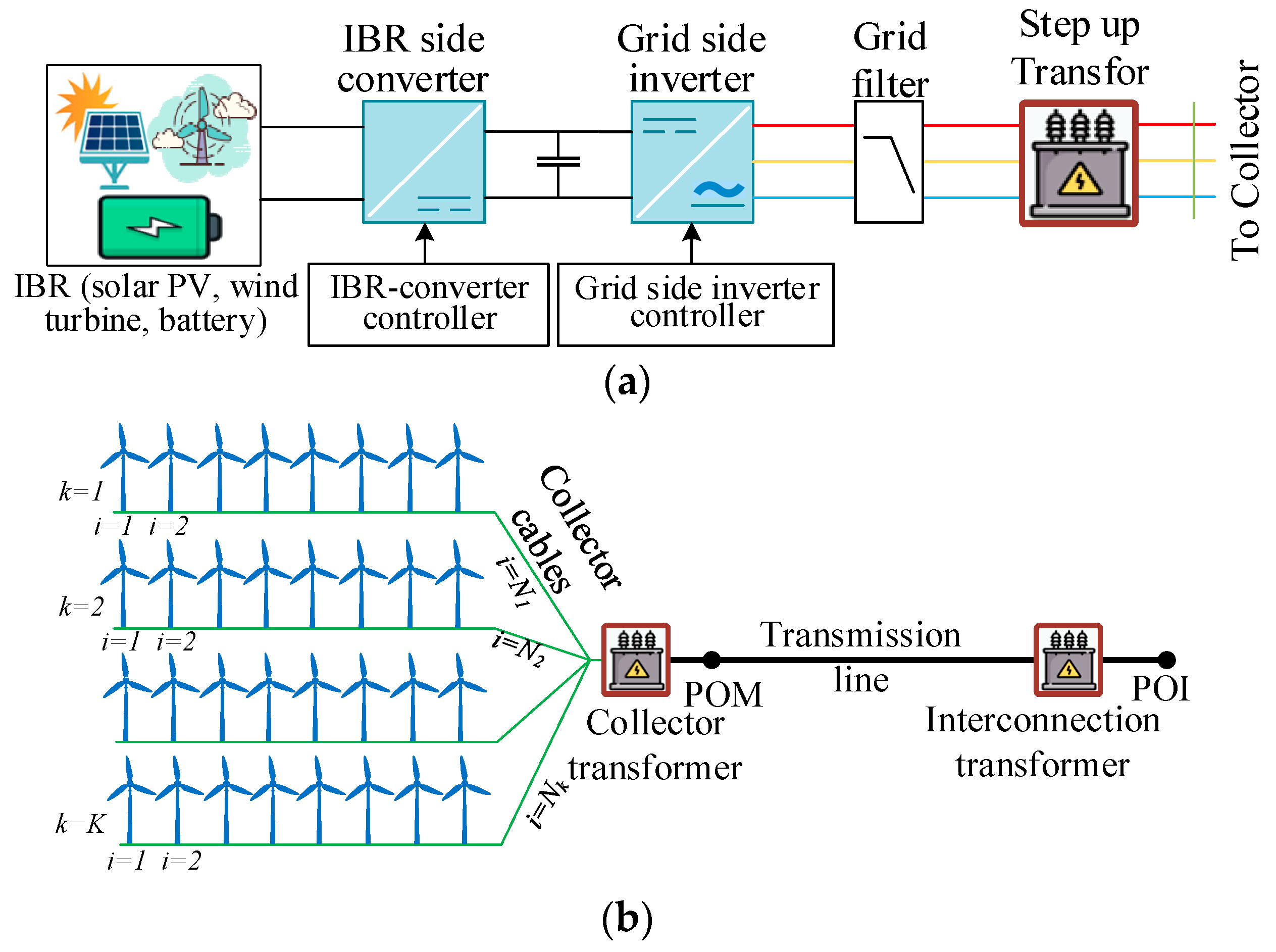


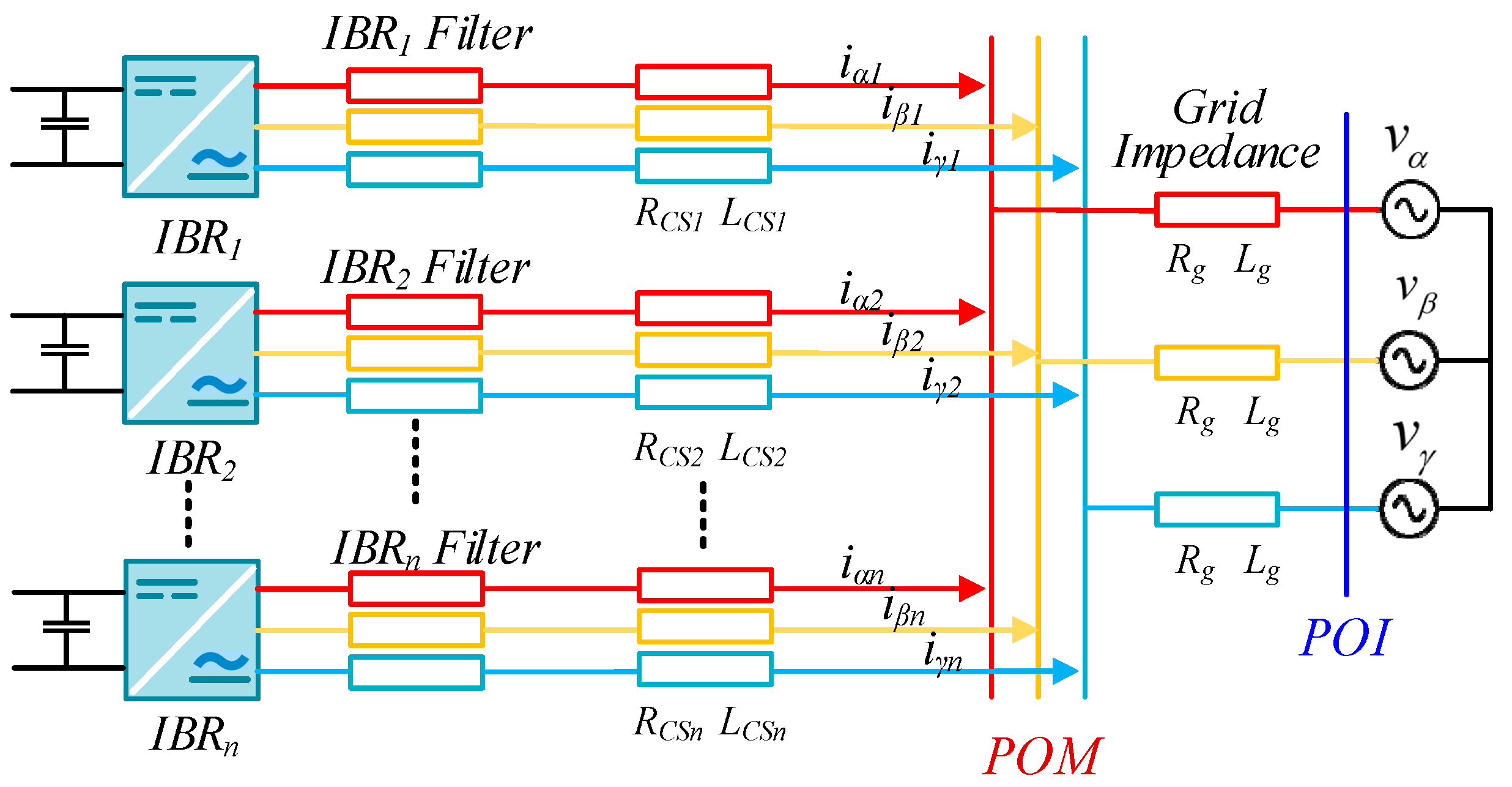


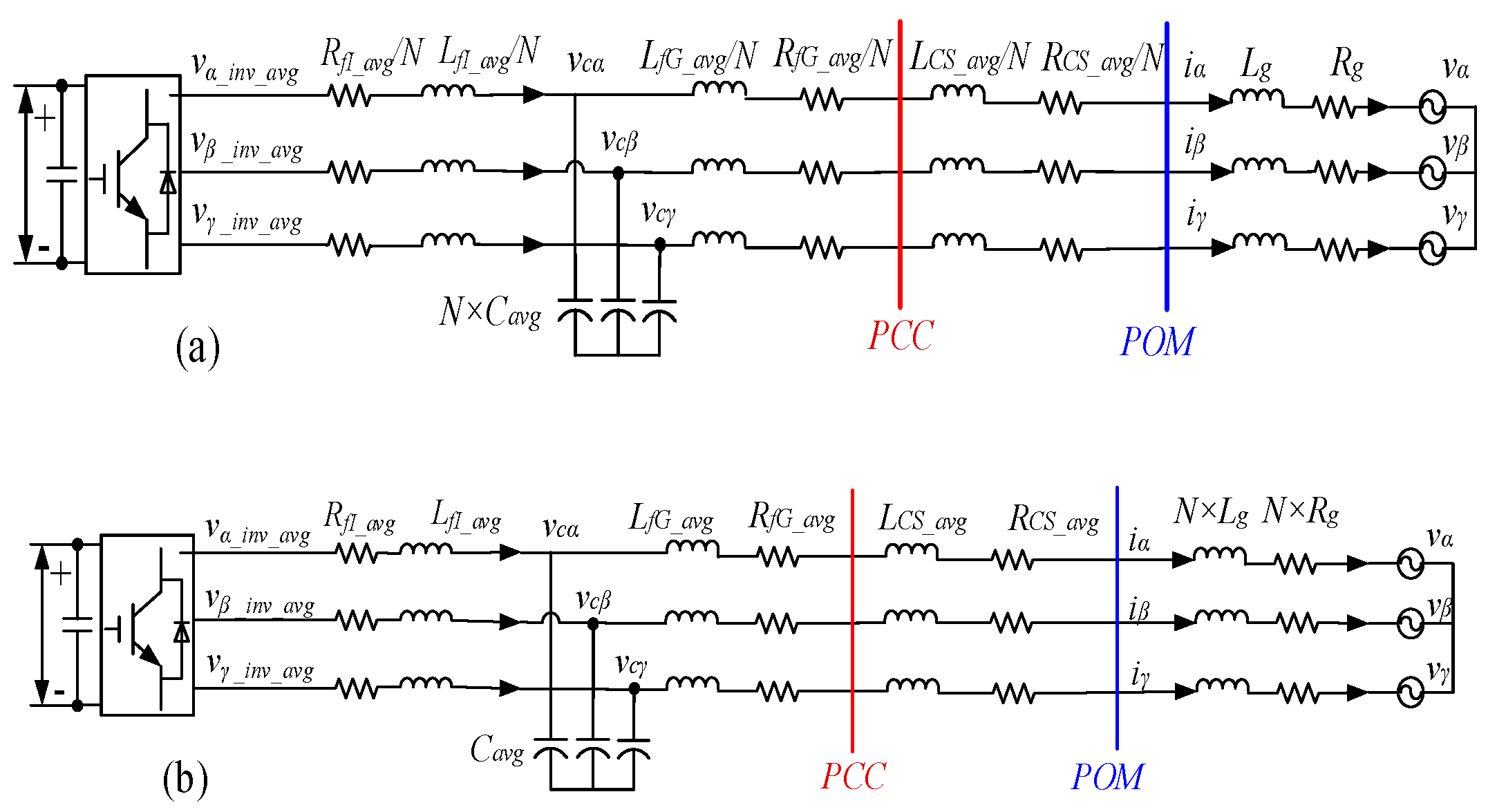
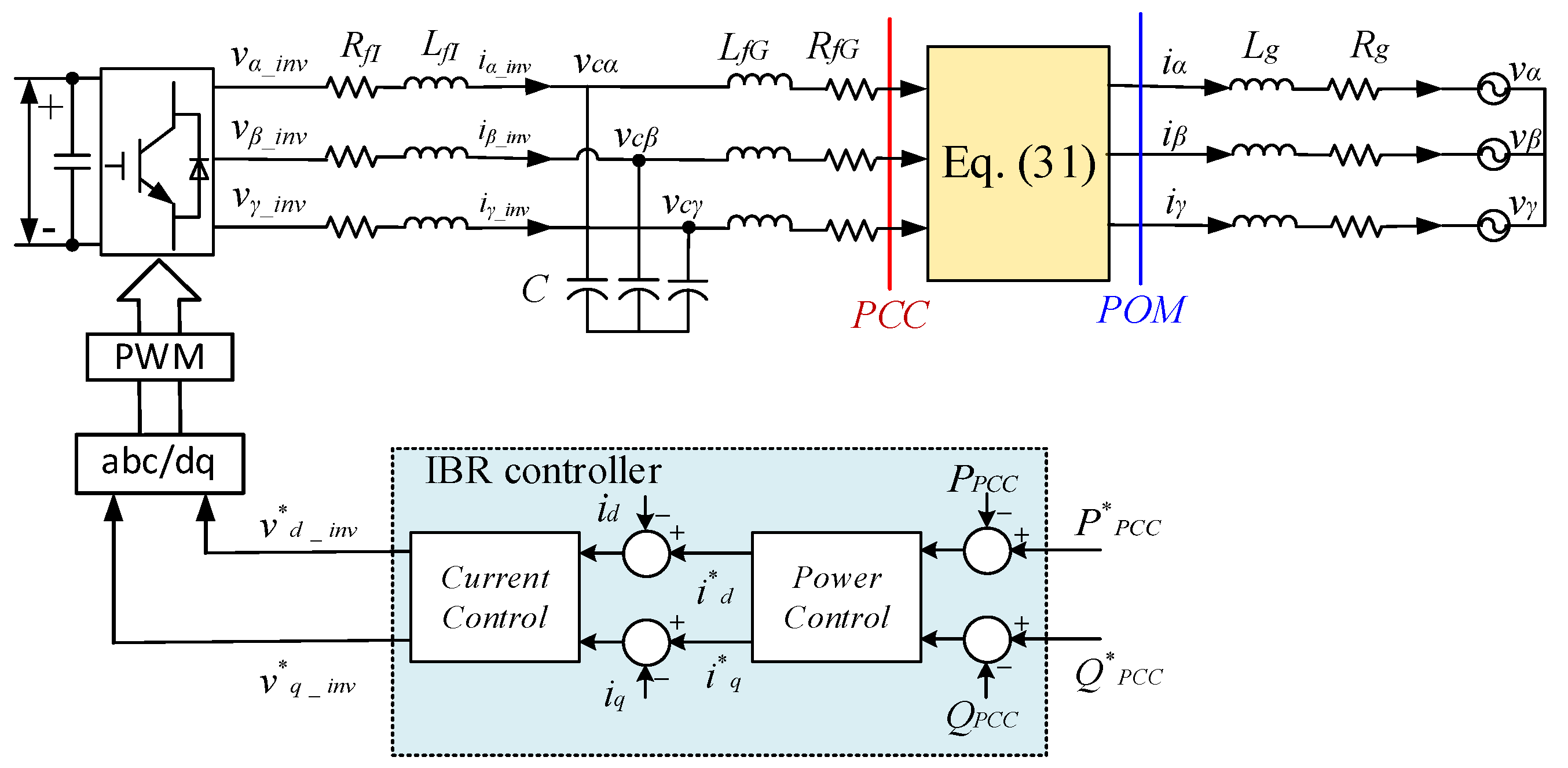
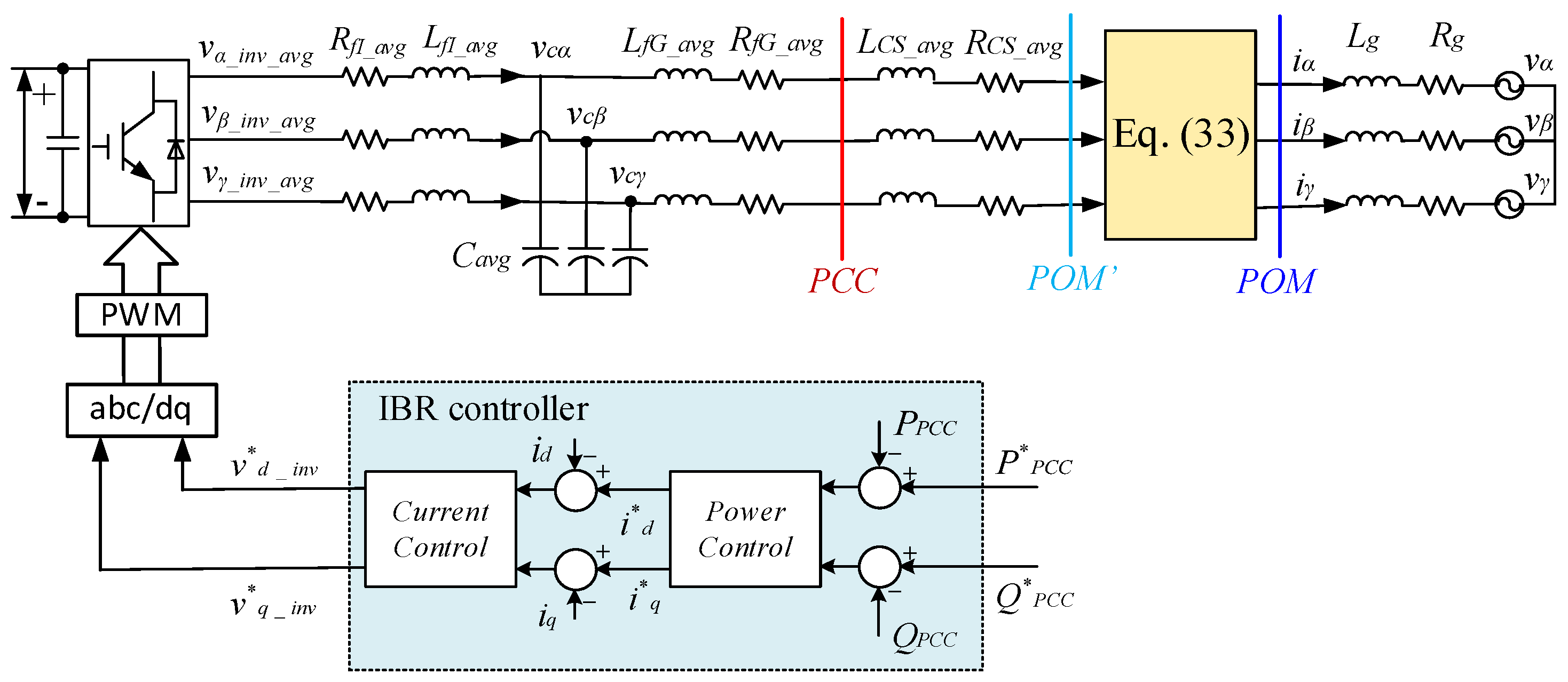




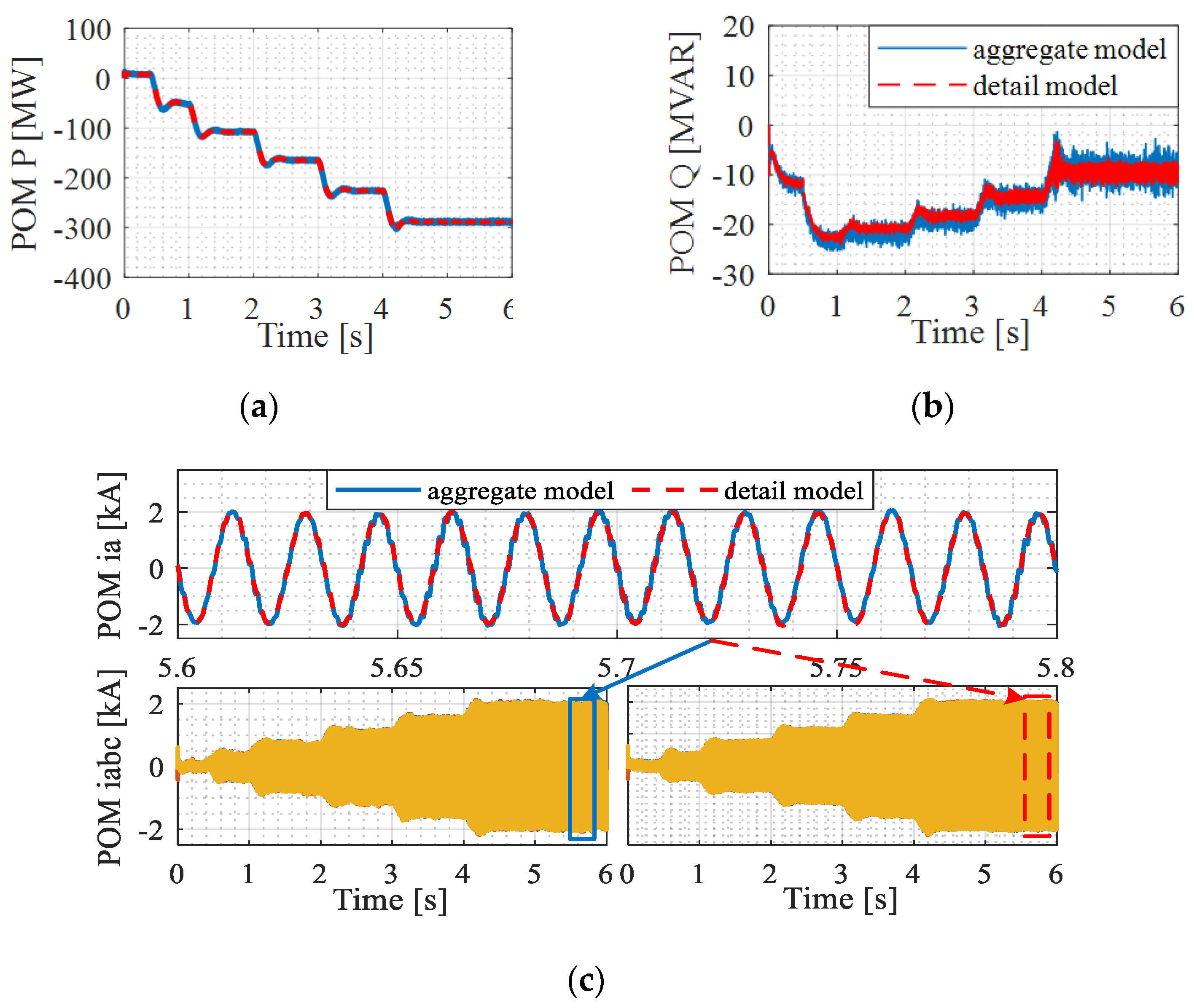
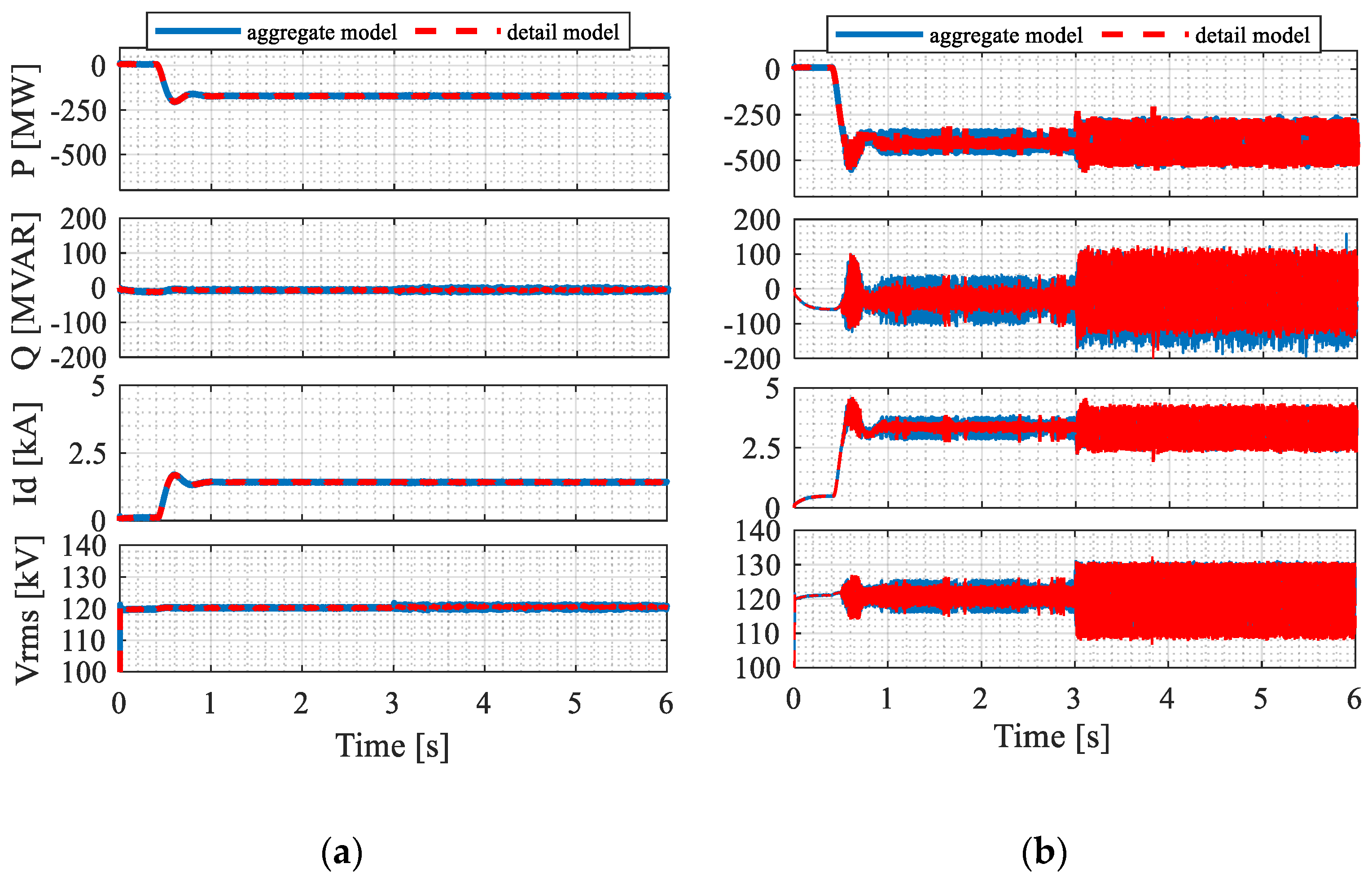
| Refs. | Source Type | Configuration Type | No. of Units | Simulation Method | Comments |
|---|---|---|---|---|---|
| [5] | WT | Parallel | Variable | Load flow | WTs vary in capacity, operating conditions, and parameters. |
| [6] | WT | Parallel | Variable | Phasor simulation | Applicable to any type of induction generators. |
| [7] | WT | Parallel | Variable | Phasor simulation | The accuracy increases with the number of WTs. |
| [8] | WT | Series, Parallel | Variable | EMT | Detailed transient modeling and EMT simulation is absent. |
| [9] | WT | Not Specified | 168 | Phasor simulation | Consider diversity in wind speed, collector network impedance, and type of WTs. |
| [10] | WT | Series | 12 | Phasor simulation | Provide an inaccurate response when the output power is larger than the grid short circuit capacity. |
| [11] | PV | Not Specified | Not Specified | EMT | Applicable for PV units of different locations and scales. |
| [12] | PV | Series, Parallel | 100 | Phasor simulation | Focus on the active and reactive power dynamics at the POI. |
| [13,14] | DG | Series, Parallel | 50 | EMT | Focus on developing an aggregate model for a group of droop-controlled inverters. |
| [15] | RESs | Parallel | Variable | EMT | Focus on developing an aggregate model for the power circuit of the converters. |
| [16,17] | Inverters | Parallel | Variable | Phasor simulation | Collector system impact is not considered. |
| [18] | WT | Series, Parallel | Variable | Computational | Develop an aggregate model focused on the LVRT characteristic and Wake effect. |
| [19] | WT | Series, Parallel | Variable | Phasor simulation | Focus on the difference in rotor speed of each WT and the frequency coupling effect. |
| [20,21] | WT | Parallel | Variable | Computational | Does not consider LVRT control, and reactive power capability limit. |
| [22] | WT | Series, Parallel | Variable | EMT | Does not consider collector network transformation. |
| [23] | WT | Series, Parallel | Variable | Computational | Focuses on clustering of WT in the plant. Does not focus on individual WT control. |
| [24] | WT | Series, Parallel | 66 | Computational | Focuses on clustering of WT in the plant. Does not focus on individual WT control. |
| [25] | WT | Series | Variable | EMT | Does not focus on WT control. |
| Proposed model | WT/PV/Battery | Series, Parallel, combined | Variable | EMT | Considers collector network transformation, low computational complexity, scalable for lower number to very high number of IBRs, ready for EMT simulation, can verify individual IBR parameter properties. |
| Parameter | Values |
|---|---|
| Renewable energy source voltage | 690 Vrms |
| DC bus voltage | 1500 V |
| PCC voltage before transformer | 690 Vrms |
| Source side filter inductance (L filter) | 0.4 mH |
| Source side filter resistance (L filter) | 3 mΩ |
| DC bus capacitance | 0.2 F |
| Grid side LCL filter inductance (Lf, Lg) | 0.28 mH |
| Grid side LCL filter resistance (Rf, Rg) | 3 mΩ |
| Grid side LCL filter capacitance (Cf) | 56 µF |
| Grid side LCL filter capacitor resistance (CRf) | 0.4 Ω |
| PCC transformer (690/25kV) | 1.5 MVA |
| Collector transformer (25kV/120kV) | 1500 MVA |
| Collector impedance | Varies with plant structure |
| Transmission line impedance | 144 mΩ, 3.8 mH (SCR = 4.4) 480 mΩ, 12.7 mH (SCR = 2.1) |
| Grid impedance at POI (X/R ratio) | 5.6 |
| No of IBR = 600 | Voltage THD (%) | Current THD (%) | |
|---|---|---|---|
| Case 1 | Aggregated model | 1.93 | 2.94 |
| Detailed model | 1.93 | 2.94 | |
| Case 2 | Aggregated model | 1.84 | 2.65 |
| Detailed model | 1.73 | 2.61 | |
| Case 3 | Aggregated model | 2.37 | 3.83 |
| Detailed model | 1.94 | 2.99 | |
| Case 4 | Aggregated model | 2.5 | 4.06 |
| Detailed model | 2.07 | 3.21 | |
Disclaimer/Publisher’s Note: The statements, opinions and data contained in all publications are solely those of the individual author(s) and contributor(s) and not of MDPI and/or the editor(s). MDPI and/or the editor(s) disclaim responsibility for any injury to people or property resulting from any ideas, methods, instructions or products referred to in the content. |
© 2023 by the authors. Licensee MDPI, Basel, Switzerland. This article is an open access article distributed under the terms and conditions of the Creative Commons Attribution (CC BY) license (https://creativecommons.org/licenses/by/4.0/).
Share and Cite
Das, H.S.; Li, S.; Rahman, S. Grid Interconnection Modeling of Inverter Based Resources (IBR) Plant for Transient Analysis. Energies 2023, 16, 3211. https://doi.org/10.3390/en16073211
Das HS, Li S, Rahman S. Grid Interconnection Modeling of Inverter Based Resources (IBR) Plant for Transient Analysis. Energies. 2023; 16(7):3211. https://doi.org/10.3390/en16073211
Chicago/Turabian StyleDas, Himadry Shekhar, Shuhui Li, and Shahinur Rahman. 2023. "Grid Interconnection Modeling of Inverter Based Resources (IBR) Plant for Transient Analysis" Energies 16, no. 7: 3211. https://doi.org/10.3390/en16073211
APA StyleDas, H. S., Li, S., & Rahman, S. (2023). Grid Interconnection Modeling of Inverter Based Resources (IBR) Plant for Transient Analysis. Energies, 16(7), 3211. https://doi.org/10.3390/en16073211







